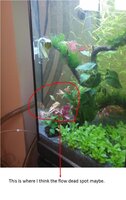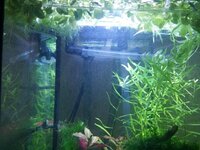Jason Blake
Member
- Joined
- 1 Sep 2014
- Messages
- 58
Hi,
I am trying to grow some Alternanthera Cardinalis but it is struggling. Nearly all of the bottom leaves have completely melted away. The stems also look like they are melting too. The leaves nearer the top most appear to have some melting around the edges as well as holes. Here are some pics




I know that this is going to be blamed on CO2 and probably more so about the flow a distribution in my aquarium. This is where I seem to be becoming unstuck. The reasons being that my Drop checker is limade green at lights on and goes almost yellow during the day (No livestock as yet). It was my belief that the sign of good flow was the plants waving gently in the breeze, which they all do. So I am really struggling to work out where my problem lays. Below is a bried video of, focusing mainly on the area of the Cardinalis as this seems to be the only plant showing any problems. All other plants seem to be doing vey well especially the Heteranthera Zosterfolia, that has gone bizerk. So much for Tropica grading this as a plant for the apprentice!
Here are some stats that I hope will help provide an answer.
CO2 on at 09:00 Off at 17:00
CO2 Infusion = UP Inline Diffuser
Lights on at 12:00 off at 18:00
Lights = 1 x PL 11w Compact Flourescent
EI dosing = Macro 3 x a week, Micro 3 x a week, One day of Rest. One x 50% water change
Tank = 60 Litre Hexagon - 50cm Tall x 38 Wide
Filtration = 1000 LPH
I would really appreciate any construction comments.
Thanks.
I am trying to grow some Alternanthera Cardinalis but it is struggling. Nearly all of the bottom leaves have completely melted away. The stems also look like they are melting too. The leaves nearer the top most appear to have some melting around the edges as well as holes. Here are some pics




I know that this is going to be blamed on CO2 and probably more so about the flow a distribution in my aquarium. This is where I seem to be becoming unstuck. The reasons being that my Drop checker is limade green at lights on and goes almost yellow during the day (No livestock as yet). It was my belief that the sign of good flow was the plants waving gently in the breeze, which they all do. So I am really struggling to work out where my problem lays. Below is a bried video of, focusing mainly on the area of the Cardinalis as this seems to be the only plant showing any problems. All other plants seem to be doing vey well especially the Heteranthera Zosterfolia, that has gone bizerk. So much for Tropica grading this as a plant for the apprentice!
Here are some stats that I hope will help provide an answer.
CO2 on at 09:00 Off at 17:00
CO2 Infusion = UP Inline Diffuser
Lights on at 12:00 off at 18:00
Lights = 1 x PL 11w Compact Flourescent
EI dosing = Macro 3 x a week, Micro 3 x a week, One day of Rest. One x 50% water change
Tank = 60 Litre Hexagon - 50cm Tall x 38 Wide
Filtration = 1000 LPH
I would really appreciate any construction comments.
Thanks.





